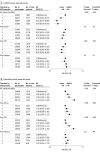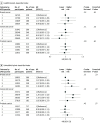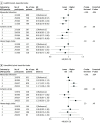Association of Healthful Plant-based Diet Adherence With Risk of Mortality and Major Chronic Diseases Among Adults in the UK
- PMID: 36976560
- PMCID: PMC10051114
- DOI: 10.1001/jamanetworkopen.2023.4714
Association of Healthful Plant-based Diet Adherence With Risk of Mortality and Major Chronic Diseases Among Adults in the UK
Abstract
Importance: Plant-based diets have gained popularity for both environmental and health reasons, but a comprehensive assessment of their quality in relation to risk of mortality and major chronic diseases is lacking.
Objective: To examine whether healthful vs unhealthful plant-based dietary patterns are associated with mortality and major chronic diseases among UK adults.
Design, setting, and participants: This prospective cohort study used data from adults in the UK Biobank, a large-scale population-based study. Participants were recruited between 2006 and 2010 and followed up using record linkage data until 2021; follow-up for different outcomes ranged between 10.6 and 12.2 years. Data analysis was conducted from November 2021 to October 2022.
Exposures: Adherence to a healthful vs unhealthful plant-based diet index (hPDI vs uPDI) derived from 24-hour dietary assessments.
Main outcomes and measures: The main outcomes were hazard ratios (HRs) and 95% CIs of mortality (overall and cause specific), cardiovascular disease (CVD [total, myocardial infarction, ischemic stroke, and hemorrhagic stroke]), cancer (total, breast, prostate, and colorectal), and fracture (total, vertebrae, and hip) across quartiles of hPDI and uPDI adherence.
Results: This study included 126 394 UK Biobank participants. They had a mean (SD) age of 56.1 (7.8) years; 70 618 (55.9%) were women. The majority of participants (115 371 [91.3%]) were White. Greater adherence to the hPDI was associated with lower risks of total mortality, cancer, and CVD, with HRs (95% CIs) of 0.84 (0.78-0.91), 0.93 (0.88-0.99), and 0.92 (0.86-0.99), respectively, for participants in the highest hPDI quartile compared with the lowest. The hPDI was also associated with lower risks of myocardial infarction and ischemic stroke, with HRs (95% CIs) of 0.86 (0.78-0.95) and 0.84 (0.71-0.99), respectively. By contrast, higher uPDI scores were associated with higher risks of mortality, CVD, and cancer. The associations observed did not show heterogeneity across strata of sex, smoking status, body mass index, or socioeconomic status or with polygenic risk scores (specifically with regard to CVD end points).
Conclusions and relevance: The findings of this cohort study of middle-aged UK adults suggest that a diet characterized by high-quality plant-based foods and lower intakes of animal products may be beneficial for health, irrespective of established chronic disease risk factors and genetic predisposition.
Conflict of interest statement
Figures




References
Publication types
MeSH terms
Grants and funding
LinkOut - more resources
Full Text Sources
Medical

